Are you a gardening enthusiast looking to add stunning hydrangeas to your landscape? Discovering the best time of year to plant these vibrant flowers is key to ensuring their successful growth and blooming. Read on as we dive into the optimal planting season for hydrangeas.
Hydrangeas in World Culture
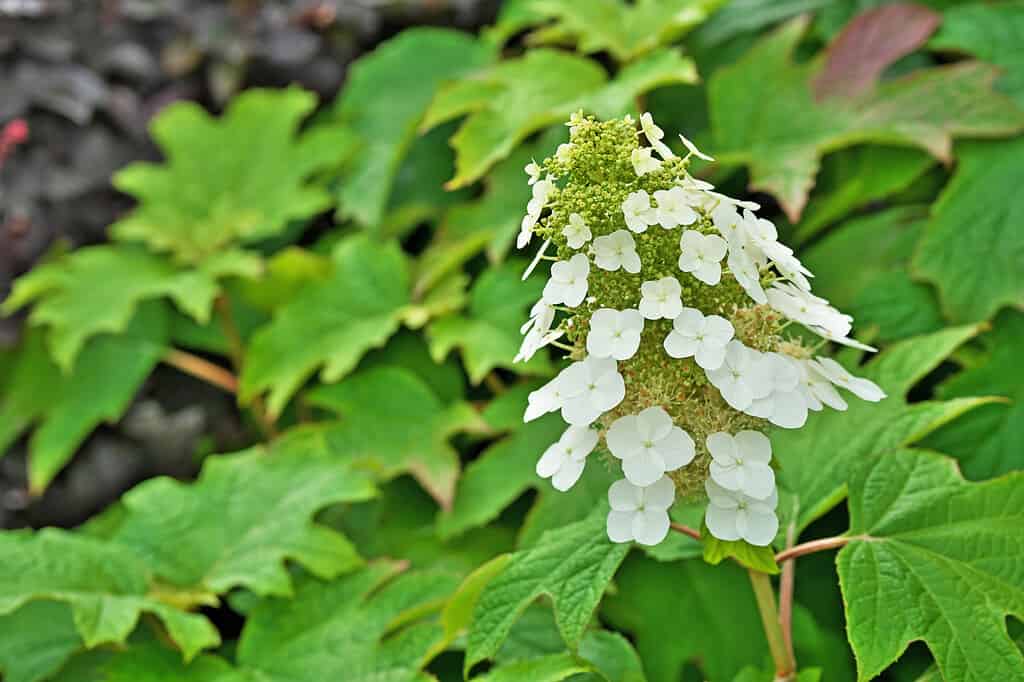
The Cherokee people believe that Hydrangea quercifolia had medicinal properties.
©igaguri_1/iStock via Getty Images
Widely known for their bright-colored blooms, hydrangeas have been around for centuries. Originating in eastern and southern Asia (Japan, China, Korea), people brought hydrangeas to Europe at the end of the 18th century. Since then, these flowering shrubs have become a popular garden addition across the globe.
In Japan, people make the hydrangea leaves of mountain hydrangeas into a sweet tea. They first steam the leaves and then dry them until dark brown. People in Japan use this tea during a celebration of the Buddha’s birthday. It is both enjoyed by the attendees and poured on a Buddha statue.
In Korea, mountain hydrangea tea is popular. There, people drink it for both enjoyment and health.
In Asia, pink hydrangeas are symbols of heartfelt emotion and gratitude. They associate the color pink with love and appreciation, making pink hydrangeas the perfect way to show someone how much you care. They are often given as gifts to express love and admiration, making them a popular choice for special occasions like weddings and anniversaries. Pink hydrangeas are also a symbol of friendship and positivity, making them a great choice for decorating and bringing cheer to any home.
Alabama loves hydrangeas so much that they made the wild hydrangea their official state flower in 1999.
When to Plant Hydrangeas

Plant hydrangeas when they are dormant.
©SutidaS/Shutterstock.com
The best times of the year to plant hydrangeas are in early spring or fall, although you can plant them in late winter as long as the soil is workable and the plants are dormant. This will provide them with enough time to grow deep roots before hot or cold weather hits. Planting early gives the plants a better chance of surviving the winter and doing well in the summer.
It’s important to note that hydrangeas should be planted at least two months before the first frost. This will give them time to become established and will help them survive the winter. Furthermore, hydrangeas require at least one inch of water per week, so make sure to keep them well-watered during the first growing season. With proper care, your hydrangeas should have no problem surviving the winter and will be ready to bloom come spring.
How to Plant Hydrangeas
Plant hydrangeas in a sunny to partially shady area that is well-drained and rich in organic matter. If your soil is poor, consider adding compost or other amendments before planting. Dig a hole that’s about twice as wide and deep as the root ball of the hydrangea plant, then place the plant into the hole at the same depth it was growing previously. Fill in around the base of the plant with amended soil until you have filled in all air pockets and the soil is level with the surrounding area. Gently tamp down the soil and water thoroughly. Add mulch around the base of the plant to help retain moisture and prevent weeds from growing. Finally, apply a slow-release fertilizer in early spring to provide nourishment for your hydrangeas throughout their growing season.
Hydrangea Colors and Soil Acidity
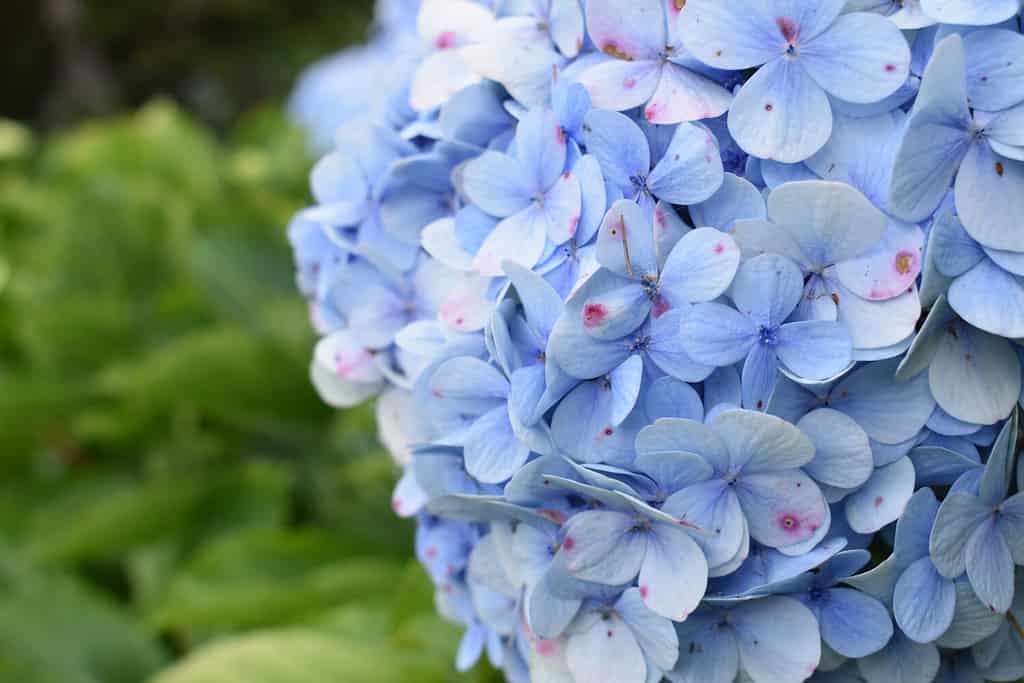
If you want blue hydrangeas flowers, create soil acidity of 5.5 or lower.
©Light and Vision/Shutterstock.com
The color of hydrangea flowers can be impacted by the acidity level of the soil they are planted in. If the soil pH is 5.5 or less, the flowers will be blue. When the soil pH is 6.5 or higher, they will be pink. If you make the soil acidity level between 5.5 and 6.5, the flowers will turn purple. White hydrangeas cannot be changed since they don’t produce any coloring.
To ensure that your hydrangea plants produce the desired colors, you can adjust the pH of your soil. The best way to do this is by adding sulfur or aluminum sulfate to acidic soils and lime or wood ash to alkaline soils. Test the pH level of your soil before planting and make adjustments as needed. Once planted, check the soil’s acidity every two years and adjust accordingly if necessary.
Hydrangea Care Tips
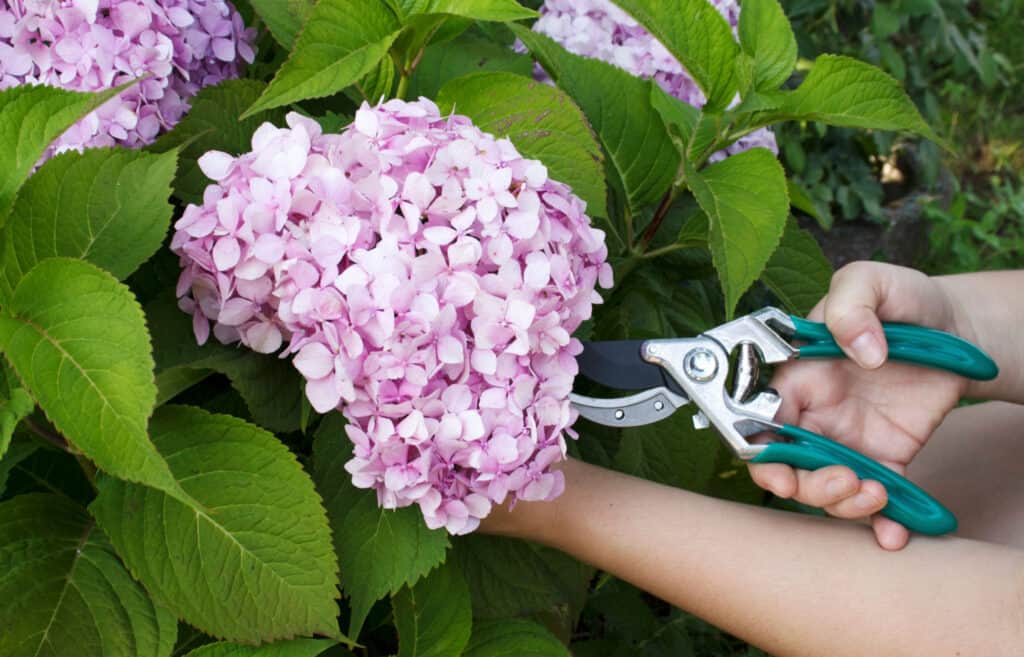
Hydrangeas make great cut flowers. Take some into your home and enjoy them!
©Natallia Ustsinava/Shutterstock.com
- Make sure your hydrangea is planted in a location that receives plenty of sunlight. Most hydrangeas prefer full sun in the morning and partial shade in the afternoon.
- Water your hydrangea regularly, but be careful not to overwater. Hydrangeas need about 1-2 inches of water per week. Some hydrangeas, especially oakleaf, do not like soggy soil.
- Fertilize your hydrangea in the spring and summer months. Use a slow-release fertilizer that is specifically designed for hydrangeas.
- Prune your hydrangeas after they have finished flowering for the season. Do not wait until fall, or you could accidentally cut off next year’s buds.
- Remove dead or damaged leaves and stems from the plant. This will help to keep the plant healthy and prevent disease.
- Mulch around your hydrangeas to help retain moisture and keep weeds at bay.
- Be sure to keep an eye out for pests and diseases. Check your plants regularly for common hydrangea pests like Japanese beetles, spider mites, and aphids.
- Plant your hydrangeas in well-drained soil. Hydrangeas do not like to be waterlogged, so make sure your soil has good drainage. If you have clay soil, add manure, shredded leaves, or compost to help drainage.
- If you live in a cold climate, be sure to protect your hydrangeas during the winter months. Wrap them in burlap or cover them with a frost blanket to protect them from the cold. Covering the base of the plant with at least 12 inches of bark or leaves is a wonderful insulation.
- Hydrangeas are beautiful flowers that last up to 9 days indoors. To put them in a vase, carefully snip the stems with sharp pruning shears. Fill the vase with cold water and flower food and position them as desired. Leave the vase in a cool spot away from direct sunlight and change the water every few days.
The 5 Different Types of Hydrangeas
People love to grow hydrangeas for their beautiful blooms and lush foliage. Hydrangeas come in a variety of sizes, shapes, and colors, making them a versatile choice for any garden. Their large, showy blooms provide a stunning display in any garden, and their wide range of colors can bring life and vibrancy to even the most dull landscape.
Bigleaf Hydrangeas

This lacecap hydrangea is one of three types of bigleaf hydrangeas.
©JohnatAPW/Shutterstock.com
Bigleaf Hydrangeas are the most popular and common type of hydrangeas that you will find in garden centers in the U.S. Bigleaf hydrangeas come in three main varieties: mophead, lacecap, and mountain. Mophead hydrangeas have large, round blooms that give them their name. Lacecap hydrangeas have a more flattened bloom, with the center being made of small flowers surrounded by larger petals. Mountain hydrangeas are the smallest of the three and have smaller, more delicate blooms. All three varieties are popular for their showy flowers and attractive foliage. Mophead hydrangeas are best suited for sunny areas, while lacecap and mountain hydrangeas prefer some shade.
Panicle Hydrangeas

Hydrangea paniculata has lovely cone-shaped flowers. Butterflies love them!
©Flower_Garden/Shutterstock.com
Panicle Hydrangeas (Hydrangea paniculata) is a type of deciduous shrub with broad clusters of white or pink flowers. They are native to Eastern Asia, growing in moist woodland areas, but now people grow them in many parts of the world.
Panicle Hydrangeas can grow up to 15 feet tall and have oval leaves and long, conical flower heads. The flowers can be single or double, and their color can vary from white to pink or blue-violet. This type of hydrangea is very cold hardy and will grow in zones 3 through 7.
Smooth Hydrangeas
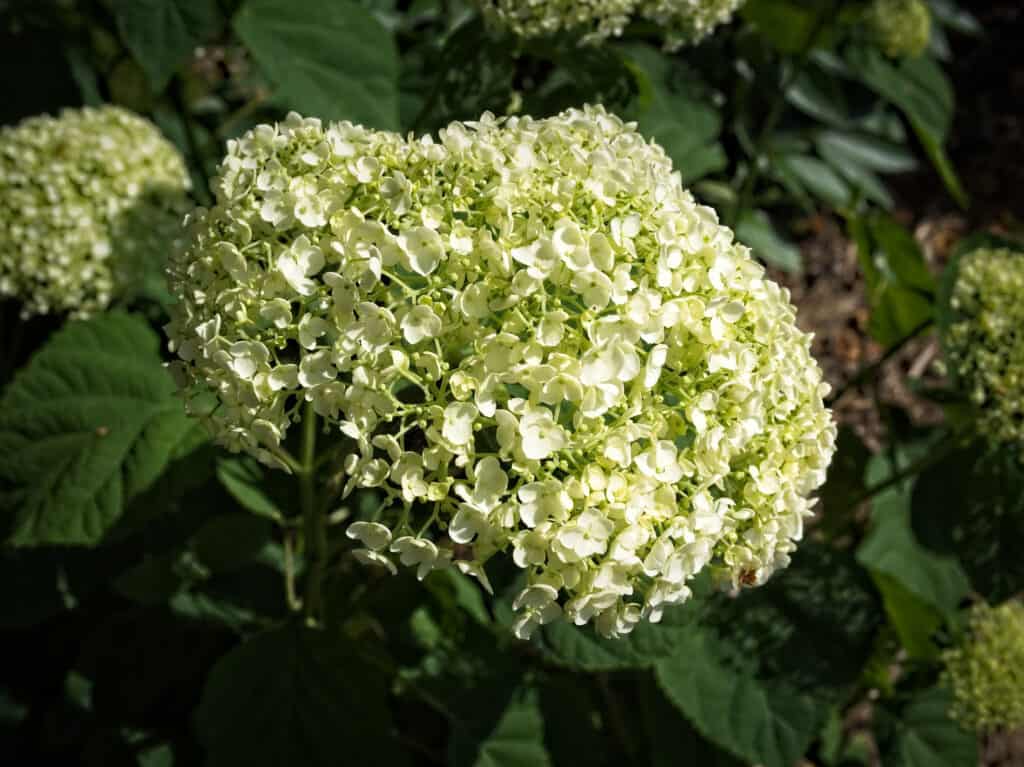
This Incrediball hydrangea is a new cultivar with very strong stems.
Wild hydrangeas, also known as smooth hydrangeas, are native to the United States and can tolerate zones 4 to 7. These plants are great for hedges due to their considerable size (up to 10 feet). They are distinguishable from mophead hydrangeas by their thinner, floppier leaves with a matte surface and coarser texture. Annabelle hydrangea is the most renowned variety of this type and can survive in cold temperatures as low as Zone 3a. It has white flowers that turn a light green color. The Incrediball hydrangea is a newer version of Annabelle that has stronger stems and more plentiful blooms. Smooth hydrangeas are highly adaptable to both warm and cold climates, making them an ideal choice for planting.
Oakleaf Hydrangeas
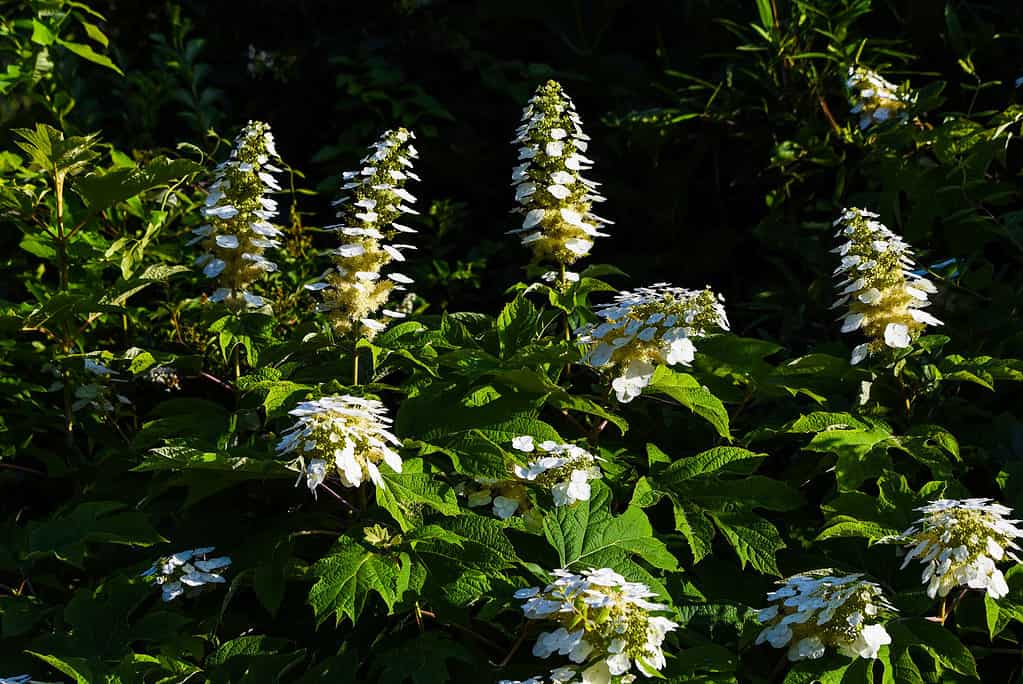
The oakleaf hydrangea will grow in the shade.
©iStock.com/undefined undefined
Oakleaf hydrangeas are a beautiful flowering shrub that grows in many regions of the world. Their scientific name is Hydrangea quercifolia, and they have large clusters of showy white or pink flowers. The foliage is large, dark green, and coarsely toothed, with an oak-like shape. The shrub can reach up to 10 feet in height and is an ideal choice for both formal and informal gardens. The bloom time for oakleaf hydrangeas is usually late spring to early summer, and the flowers are long-lasting. They prefer habitats that are moist but not wet and are tolerant of a variety of soils. Oakleaf hydrangeas like a nice hot summer to bloom well but are hardy in zones 5-9.
Climbing Hydrangeas
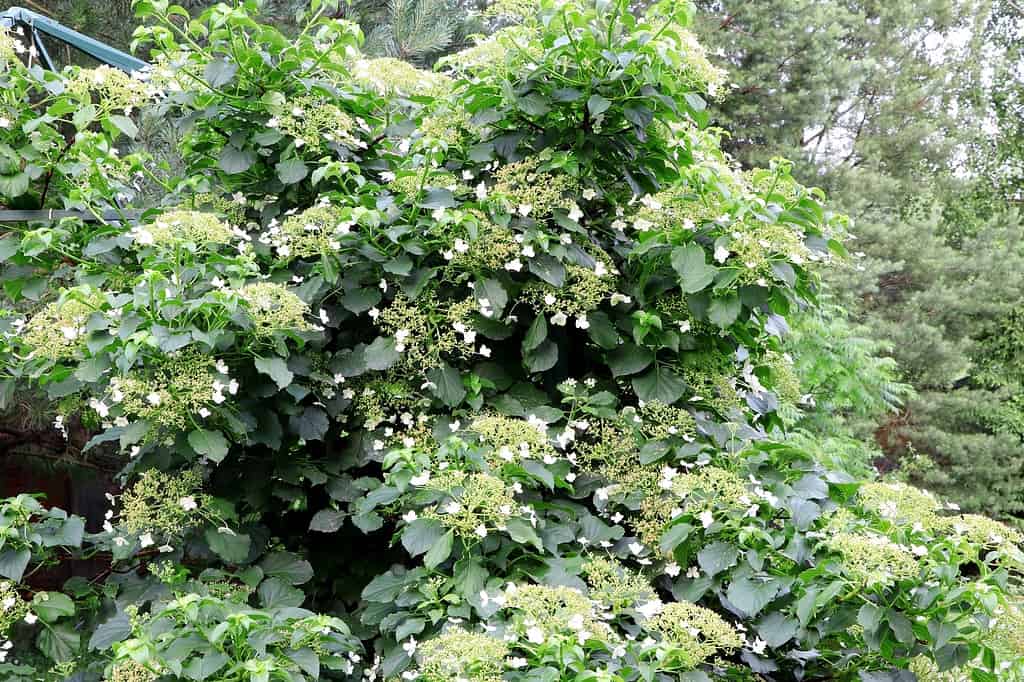
Hydrangea petiolaris blooms in the summer and can grow up to thirty feet tall.
©Mikhail Kolomiets/ via Getty Images
Climbing hydrangeas are a species of flowering vine that grows straight up walls, fences, and other surfaces. They produce large clusters of white flowers that bloom in summer and add a burst of color and life to any outdoor space. The lush, evergreen foliage provides year-round coverage, making them a great addition to any yard or garden. Climbing hydrangeas are hardy and can survive in USDA Hardiness Zones 5 to 9. They are easy to care for and require little maintenance, making them an excellent choice for any garden.
The photo featured at the top of this post is © Baber Photography/iStock via Getty Images
Thank you for reading! Have some feedback for us? Contact the AZ Animals editorial team.







